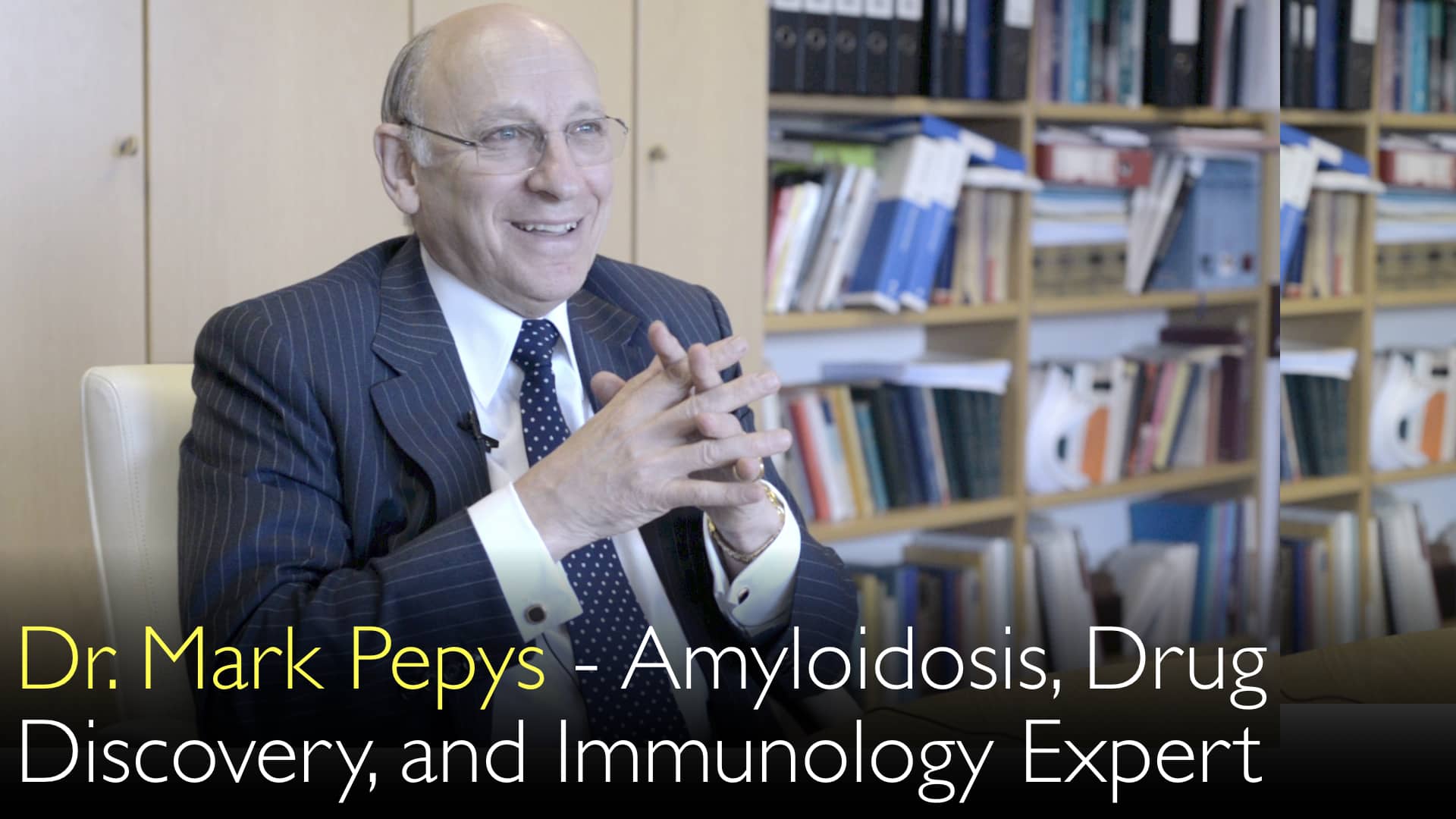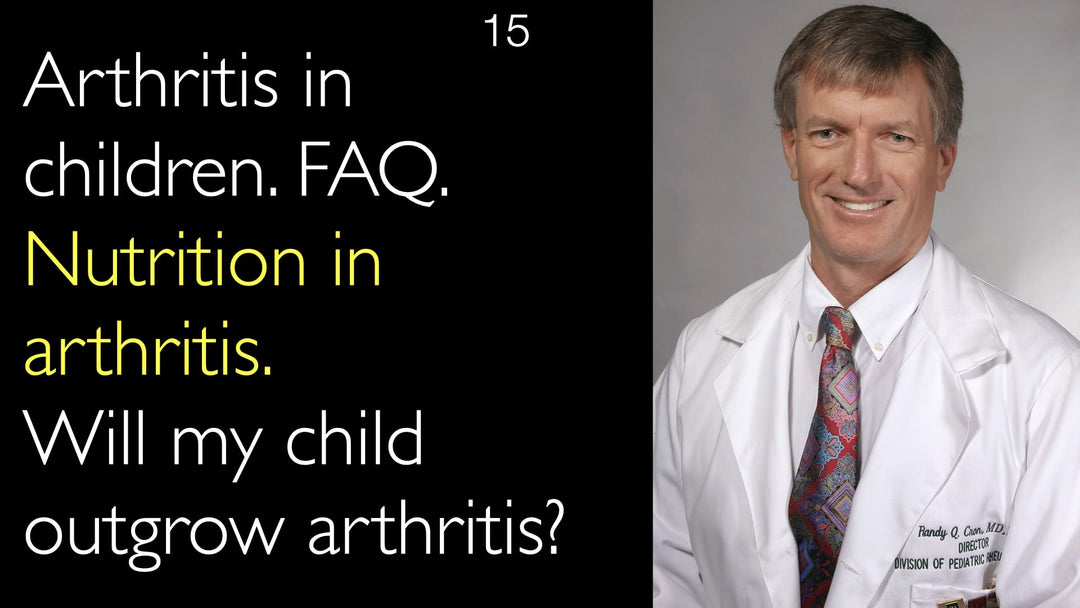מומחה מוביל בטיפול בעמילואידוזיס, ד"ר מארק פפס, MD, מסביר על מחקרו פורץ הדרך בשיטת טיפול חדשנית. עבודתו מתמקדת בחלבון רכיב העמילואיד P בסרום (SAP) שמצפה את כל משקעי העמילואיד. ד"ר פפס פיתח טיפול דו-שלבי שמפחית תחילה את רמות ה-SAP מהדם. לאחר מכן, נוגדן שני מכוון ל-SAP הנותר על סיבי העמילואיד. זה מפעיל את המנגנונים הטבעיים של הגוף להסרת העמילואיד המזיק. ניסויים קליניים מראים שגישה זו בטוחה ויכולה לפנות עמילואיד מאיברים בצורה דרמטית.
טיפול חדשני דו-שלבי להסרת עמילואידוזיס
קפיצה לפרק
- הבנת הביולוגיה של העמילואיד
- תפקיד חלבון SAP בהישרדות העמילואיד
- פיתוח הטיפול הראשוני
- תוצאות הניסוי הקליני והשערה חדשה
- טיפול נוגדני פורץ דרך
- סטטוס הפיתוח הנוכחי
- תמליל מלא
הבנת הביולוגיה של העמילואיד לצורך טיפול
ד"ר מארק פפיס, MD, מדגיש שהבנת הפתוביולוגיה של המחלה היא המפתח לפיתוח טיפולים חדשים. במקרה של עמילואידוזיס, המשמעות הייתה חקירת הסיבה שבגללה חלבונים ספציפיים מתקפלים בצורה לא תקינה ויוצרים סיבי עמילואיד. ד"ר אנטון טיטוב, MD, דן בחשיבות ההבנה כיצד סיבים אלה פוגעים ברקמות ומדוע הגוף אינו מסוגל להסירם. מחקר יסודי זה into הליקוי הביולוגי הבסיסי היה הצעד הראשון הקריטי שהוביל לכל הפיתוח הטיפולי שבא לאחר מכן.
תפקיד חלבון SAP בהישרדות העמילואיד
תגלית מרכזית הייתה הנוכחות הקבועה של רכיב P עמילואידי בסרום (SAP) בכל משקעי העמילואיד. ד"ר מארק פפיס, MD, גילה ש-SAP נקשר לסיבי עמילואיד באופן תלוי-סידן. המחקר שלו סיפק עדות משכנעת כי קישור זה תורם הן להיווצרות והן להישרדות העמילואידוזיס. ציפוי ה-SAP effectively מסווה את העמילואיד, וגורם לו להיראות תקין לתאי הפינוי של הגוף. זה מונע את הסילוק הטבעי של החומר המזיק מהאיברים והרקמות.
פיתוח הטיפול הראשוני ואתגרים
בשנות ה-80, ד"ר מארק פפיס, MD, הגה את הרעיון להפריד את ה-SAP ממשקעי העמילואיד כאסטרטגיה טיפולית. הוא זיהה מולקולה קטנה, שנקראה later CPHPC, שיכלה להשיג דיסוציאציה זו בתנאי מעבדה. Initially, חברות התרופות showed little interest בגלל שעמילואידוזיס היא מחלה נדירה. עם זאת, הקשר למחלת אלצהיימר, שכוללת עמילואיד במוח, later spurred investment. שיתוף פעולה עם רוש הוביל לפיתוח CPHPC, תרופה שנועדה להסיר SAP.
תוצאות הניסוי הקליני והשערה חדשה
הניסויים האנושיים הראשונים ב-CPHPC כללו 30 חולים עם עמילואידוזיס מערכתי שטופלו במשך שנה עד שנתיים. ד"ר מארק פפיס, MD, מדווח שהתרופה הייתה "בטוחה להפליא" ללא תופעות לוואי. היא הצליחה להסיר virtually את כל ה-SAP מהדם within a day through a novel pharmacological mechanism. עם זאת, while it removed a lot of SAP from the amyloid deposits, some always remained, and the amyloid itself did not go away. תוצאה זו הובילה את ד"ר פפיס לגבש רעיון טיפולי חדש ומרכזי.
טיפול נוגדני דו-שלבי פורץ דרך
ההשערה החדשה כללה טיפול דו-שלבי לעמילואידוזיס. ראשית, CPHPC מדלל את ה-SAP מהדם. שלב קריטי זה מאפשר את השלב השני: מתן נוגדן שתוכנן specifically כדי לתקוף את ה-SAP הנותר על משקעי העמילואיד. In transgenic mouse models, this combination therapy was 100% reproducible. A single dose of the antibody triggered the complete removal of all amyloid, "like magic," without harming the animals. הצלחה דרמטית זו הוכיחה את הרעיון שניתן לרתום את מערכת החיסון של הגוף כדי לפנות עמילואיד.
סטטוס הפיתוח הנוכחי וניסויים עתידיים
ההמצאה הורשתה לגלקסו-סמית-קליין לפיתוח מסחרי. מחקר פאזה 1 שפורסם ב-New England Journal of Medicine ב-2015 הראה תוצאות מבטיחות extremely. בחולים, הטיפול הסיר progressively and dramatically עמילואיד מהכבד, הטחול והכליות. הטיפול היה בטוח ונסבל היטב. Plans are now advancing for a Phase 2 clinical trial. המחקר הבא הזה יכלול specifically חולים עם עמילואידוזיס לבבי, הצורה החמורה והמאתגרת ביותר של המחלה לטיפול.
תמליל מלא
ד"ר אנטון טיטוב, MD: במהלך 40 השנים האחרונות, אתה נמצא בדרך הגילוי של שיטה specific לטיפול בעמילואידוזיס. האם תוכל לתאר בפירוט רב יותר את השיטה שלך לטיפול בעמילואידוזיס? מהו הגילוי שעשית?
ד"ר מארק פפיס, MD: השיטה הטיפולית שלי, או כל טיפול, היא firstly להבין את הפתוביולוגיה של המחלה, כולל עמילואידוזיס. It is key to devise new treatment for any disease.
ד"ר אנטון טיטוב, MD: מהו הליקוי הבסיסי בביולוגיה? מהו התפקוד של האדם שחלה בעמילואידוזיס?
ד"ר מארק פפיס, MD: In the first place, I have been studying that for many years. What are the processes involved in amyloid formation? Why do these proteins misbehave in the way that they do?
ד"ר אנטון טיטוב, MD: What are the properties of the amyloid once it is formed? How does amyloid damage the tissue?
ד"ר מארק פפיס, MD: We came to this conclusion. Possibly one of the reasons why the body doesn't remove amyloid fibers is this: because there is always another protein associated with them. As I said before, there are about 30 different molecules—different proteins that can form amyloid fibrils in the body. We see them in different types of amyloidosis.
But regardless of the protein that makes the amyloid fibrils, there is always another protein that is bound to the protein fibrils. That protein is called serum amyloid P component, or SAP for short.
Before I started working in the field of amyloidosis, it was known that this protein was present in all amyloid deposits. It was always present, but nobody knew why SAP was there.
ד"ר אנטון טיטוב, MD: What was it doing there?
ד"ר מארק פפיס, MD: My first interest in amyloid was aroused by my discovery about SAP. The protein SAP could bind to amyloid fibrils. Indeed, SAP protein could bind to a number of other things in a calcium-dependent method.
Calcium is a mineral, obviously. Everybody has calcium in their blood; you have to have it in order to be alive. Inside the body and outside the cells, there is always calcium—a reasonably abundant amount.
In the presence of this calcium, SAP binds to all amyloid fibrils. Amyloid fibrils could form anywhere in the human body, but they always have SAP coating them.
I was intrigued from the outset by this fact. All amyloid deposits contain this protein; it is always present. It is either an amazing epiphenomenon, or it has something to do with the amyloidosis.
I have been pursuing that idea for a number of years. We gradually accumulated a convincing body of evidence. Indeed, the SAP binding to amyloid fibrils contributes to both formation and persistence of amyloidosis.
We developed a lot of this evidence; other people have got corroborative evidence.
So in the 1980s, I first had the idea of trying to separate the SAP from amyloid deposits. We discovered for the first time a small molecule that could dissociate in vitro SAP from amyloid deposits in organs of people who died.
We homogenized these organs with our small chemical, then separated these two components.
I wrote a scientific article suggesting this as a possible therapeutic treatment method. Then I visited all the major pharmaceutical companies in the world. I said, "I have got a new idea for the possible treatment of amyloidosis."
ד"ר אנטון טיטוב, MD: They said to me, "What is amyloidosis?"
ד"ר מארק פפיס, MD: It was a rare disease, and nobody was very interested in it. In that era, drug companies would not spend any effort on developing a treatment for a rare disease unless the disease would have a market of several hundred million pounds per year, at least.
That has changed in the decades since then. In the 1990s, we had a lot more evidence of SAP as a target of amyloidosis treatment.
I invented a high-throughput screen to screen for molecules that would do what I wanted to do: remove SAP or prevent SAP from binding to amyloid fibrils.
Then I was able to convince Roche, the pharmaceutical company in Basel. They agreed to collaborate on that. They did a screening for medications, and we found a leading molecule as a potential medication for amyloidosis.
Very rapidly and successfully, we produced a really promising medication intended to remove all of the SAP from amyloid deposits.
We just enabled them to start a drug discovery program, that was all. But the point I'm making is that at that time, 10 years after the original suggestion—when they had not even heard about amyloidosis in the 1990s—the drug companies were very interested in amyloid.
Because in the meantime, a man called George Glenner in America had identified the protein that makes the amyloid deposits in the brain in Alzheimer's disease.
I was working on systemic amyloidosis, which is very rare.
ד"ר אנטון טיטוב, MD: But Alzheimer's disease is probably the fourth or fifth commonest cause of death in the developed world. It is the most expensive by far in terms of the cost to society and families.
ד"ר מארק פפיס, MD: They were very interested in a treatment for Alzheimer's disease. The fact that I was primarily interested in amyloidosis was just a side issue for them.
Of course, I would like to cure Alzheimer's disease too. We were happy to collaborate together on that.
What we developed was a molecule that looked like a potential medication. We hoped it would remove SAP from amyloid deposits in the brain in Alzheimer's disease, and also remove amyloid in systemic amyloidosis, although Roche were not so interested in that.
At the time we were ready with the medication supply, all the regulatory material was in place. Toxicology had been done. The medication turned out to be very safe and well-tolerated in animals.
We were ready to do a clinical trial. Roche pharmaceutical company decided to not pursue the development any further for reasons that affect all big drug companies: they have limited resources, and clinical trials are incredibly expensive.
Therefore, they decided this was too speculative an idea or whatever.
ד"ר אנטון טיטוב, MD: There were a number of reasons we don't need to go into, but they decided to stop it.
ד"ר מארק פפיס, MD: But very generously, they let us continue to study the medication in amyloidosis. We did not study this medication in Alzheimer's disease at that stage; we studied it just in amyloidosis.
Here in this center, we gave the medication to people with systemic amyloidosis for the first time. To our astonishment, the SAP disappeared from the blood circulation of patients with amyloidosis.
This was not the purpose of our treatment. The purpose was to prevent SAP binding to the amyloid deposits; we wanted to remove the SAP that was on the amyloid deposits already.
We wanted to completely remove it because my hypothesis was that the SAP protects the amyloid from being degraded. SAP prevents amyloid from being removed by the cells that should do this.
This is still my hypothesis of amyloidosis. The body should remove amyloid from the deposits.
בדיוק! התאים שמבצעים את הסרת העמילואיד אינם בעלי קולטנים; אין מנגנון זיהוי ל-SAP (Serum Amyloid P). לכן התאים רואים גוש עמילואיד המצופה ב-SAP ברקמות; זה פשוט נראה כמו SAP שהתאים פוגשים בדם מדי יום.
זה לא נראה חריג לתאים. התקווה שלי הייתה—ועדיין קיימת פוטנציאלית—שנצטרך להסיר את כל ה-SAP, ואז התאים יראו מבנים חריגים של סיבי עמילואיד ויסירו את סיבי העמילואיד בעמילואידוזיס.
אנו יכולים להאכיל תאים בסיבים in vitro, במבחנה; הם מסירים אותם בצורה מצוינת. אך הם לא עושים זאת בגוף.
Dr. Anton Titov, MD: אז זו הייתה ההשערה.
Dr. Mark Pepys, MD: נתנו את התרופות לאנשים עם עמילואידוזיס מערכתי. מטופלים קיבלו אותה ראשונים; לא נערכו ניסויים קליניים עם מולקולה זו במתנדבים בריאים מכיוון שהייתה מולקולה בטוחה.
בתקופה ההיא של פיתוח תרופות, החוק איפשר זאת. זה עבר ישירות למטופלים עם עמילואידוזיס חמור.
הם סבלו אותה היטב; היא בטוחה לחלוטין ככל הידוע לנו. יש לנו כעת כמעט 20 שנות ניסיון עם תרופה זו; נראה שהיא מולקולה מאוד בטוחה.
היא הסירה את ה-SAP מהדם. גילינו מנגנון פרמקולוגי חדש: זה קרה כי התרופה יוצרת קשרים צולבים בין זוגות מולקולות SAP בדם והופכת אותם לקומפלקס חריג.
זה מזוהה על ידי תאי הכבד כחריג; הכבד מסיר קומפלקס עמילואיד חריג זה.
ברגע שאתה נותן תרופה זו לאנשים, ריכוז ה-SAP ירד במהירות בדם. תוך יום בערך, ה-SAP נעלם כמעט לחלוטין—לא מוסר完全ly כי הגוף ממשיך לייצר אותו, אך כמעט כולו נעלם.
זו הייתה הפתעה וגילוי חדש; זה היה המצאה חדשה. זה איפשר לנו לרשום עליה פטנט.
Dr. Anton Titov, MD: זהו צעד ראשון חיוני לפיתוח מסחרי של תרופה חדשה לריפוי עמילואידוזיס.
Dr. Mark Pepys, MD: קיווינו שתהליך זה יסיר את ה-SAP מהעמילואיד. התברר שהתרופה אינה חזקה מספיק; היא לא נקשרת ל-SAP בזיקה גבוהה מספיק כדי להתחרות successfully בקישור של SAP לעמילואיד.
התרופה שלנו מסירה את ה-SAP מהדם; היא מסירה הרבה SAP מהעמילואיד כי האינטראקציה עמילואיד-SAP היא הפיכה. אך תמיד נשאר some עמילואיד.
גילינו מספר ממצאים בניסוי הקליני שלנו ב-30 מטופלים עם עמילואידוזיס שטופלו במשך שנה עד שנתיים.
התרופה בטוחה להפליא. לא היו תופעות לוואי מהתרופה או מהדלדול ה-SAP. אך משקעי עמילואיד לא נעלמו; זה מה שרצינו שיקרה. עמילואידוזיס לא נעלם.
תקענו אז.
Dr. Anton Titov, MD: מה לעשות下一步?
Dr. Mark Pepys, MD: חשבתי על זה. זה איפשר לי לקבל רעיון חדש ושונה—שיטת טיפול major בעמילואידוזיס.
הגוף מסיר פסולת ודברים חריגים שנכנסים אליו. זה השימוש בנוגדנים. לפעמים נכנסים לגוף חיידקים או נגיפים; הגוף מגיב בייצור נוגדנים.
אלה חלבונים ספציפיים שמזהים just את האובייקט החריג. Then יש一整串 מנגנונים המערבים חלבונים רבים אחרים, מנגנונים מורכבים, ותאים.
נוגדנים יכולים להפעיל את הסרת האובייקטים המטרה; נוגדנים נקשרים לדברים שצריך להסיר מהגוף.
היה לנו נוגדן נגד SAP שיכוון למשקעי עמילואיד, אך нельзя היה לתת אותו לאנשים שעדיין had SAP במחזור הדם שלהם.
התרופה המולקולרית הקטנה שלנו הסירה effectively את כל ה-SAP מהדם, אך היא לא הסירה את כל ה-SAP מהעמילואיד. זה איפשר for the first time את האפשרות לתת נוגדנים נגד SAP כדי לכוון ל-SAP הנותר במשקעי העמילואיד.
יכולנו להפעיל תהליכים פיזיולוגיים של הסרה. זה היה מושג very novel.
תכננו first את הניסוי בעכברים. אנו יכולים to induce משקעי עמילואיד בעכברים experimentally; עכברים הם המודל הניסיוני היחיד הניתן לניהול לחקר עמילואידוזיס.
יצאנו to do this. היו לנו עכברים that were made transgenic for human SAP; הם דומים לבני אדם במונחי SAP. יש להם עמילואיד של עכבר עם human SAP עליו.
אנו יכולים לתת להם את התרופה המולקולרית הקטנה שלנו, then we give them a shot of נוגדן and see what happens.
דנו בזה במעבדה. אמרתי לעמיתיי about ריפוי עמילואידוזיס, "אחד משני דברים יכול לקרות. העכברים could explode because we will produce terrible consequences of תגובה זו שמתרחשת באיבריהם המלאים עמילואיד. Or המערכת will do what it is supposed to do."
Dr. Anton Titov, MD: זה להסיר פסולת עמילואידוזיס.
Dr. Mark Pepys, MD: עיצבתי the נוגדן עמילואידוזיס specifically to work in the pathway of removing the debris. זה what happened.
ביצענו the treatment; נתנו זריקה אחת של נוגדן לעכברים. אף אחד לא מת; אף אחד לא חלה. הסתכלנו עליהם חודש later; all the amyloid was gone, like magic!
אז זה was a dramatic step forward; that was 2005. Then we had to explore it more and show it was reproducible. It is 100% reproducible; it always happened in the experiments.
Then we filed patents on the amyloidosis antibody; it could be eventually commercialized.
Eventually, in 2009, the amyloidosis invention was licensed to GlaxoSmithKline.
Between the years around 2000, we were giving the CPHPC medication—this is the name of our small molecule medication—to patients for the first time.
Between then and the later time, Roche had divested the small amyloidosis therapy molecule completely to us. We formed a spin-out company from University College London; we owned it.
We were able to license it together with the new patents on the new invention.
Dr. Anton Titov, MD: That went to GlaxoSmithKline.
Dr. Mark Pepys, MD: They are developing amyloidosis treatment for patients. So far, it looks extremely promising.
Phase 1 study on amyloidosis was reported in the New England Journal of Medicine in July 2015. We showed that patients with systemic amyloidosis were given this treatment.
A small molecule medication called CPHPC removed SAP from the blood; some SAP was left in the amyloid. A single dose, and now a couple of doses of amyloidosis medication was tried.
We've given up to three doses to some of these patients with amyloidosis. Treatment progressively removes the amyloid; it removed amyloid dramatically from the liver, the spleen, the kidneys.
We haven't tested in that first amyloidosis study patients who had major heart involvement for safety reasons, because this is a very revolutionary and unusual treatment of amyloidosis.
It has never been given before, so we were very cautious about it. So far, the medication seems to be reasonably well tolerated; it has been safe to treat amyloidosis, and it has been efficacious.
The plans are going ahead to do a Phase 2 clinical trial to treat amyloidosis. It will look at cardiac amyloidosis.
Dr. Anton Titov, MD: This is the most important thing that we need to treat. It is going to become an effective medicine to cure amyloidosis.


![גילוי טיפול באמילואידוזיס. מומחה מוביל בטיפול באמילואידוזיס. 3. [חלקים 1 ו-2]](http://diagnosticdetectives.co.il/cdn/shop/products/Amyloidosis-Alzheimers-Diagnosis-Treatment-Second-opinion-Dr-Mark-Pepys_Diagnostic_Detectives_Network.004.jpg?v=1660978374&width=1080)
![גילוי טיפול באמילואידוזיס. מומחה מוביל בטיפול באמילואידוזיס. 3. [חלקים 1 ו-2]](http://diagnosticdetectives.co.il/cdn/shop/products/Amyloidosis-Alzheimers-Diagnosis-Treatment-Second-opinion-Dr-Mark-Pepys_Diagnostic_Detectives_Network.004_8571b464-8996-4b2b-94a5-9f31ef43b5a0.jpg?v=1660978389&width=1080)
![גילוי טיפול באמילואידוזיס. מומחה מוביל בטיפול באמילואידוזיס. 3. [חלקים 1 ו-2]](http://diagnosticdetectives.co.il/cdn/shop/products/Amyloidosis-Alzheimers-Diagnosis-Treatment-Second-opinion-Dr-Mark-Pepys_Diagnostic_Detectives_Network.004.jpg?v=1660978374&width=720)
![גילוי טיפול באמילואידוזיס. מומחה מוביל בטיפול באמילואידוזיס. 3. [חלקים 1 ו-2]](http://diagnosticdetectives.co.il/cdn/shop/products/Amyloidosis-Alzheimers-Diagnosis-Treatment-Second-opinion-Dr-Mark-Pepys_Diagnostic_Detectives_Network.004_8571b464-8996-4b2b-94a5-9f31ef43b5a0.jpg?v=1660978389&width=720)





